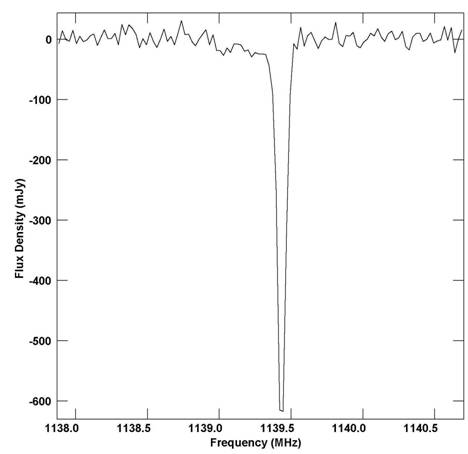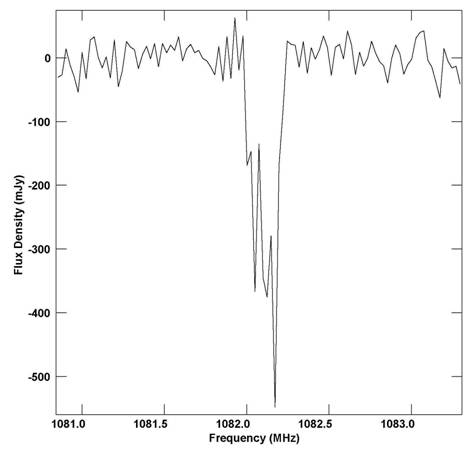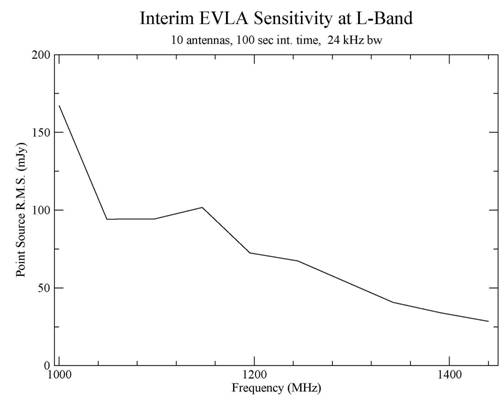Extended EVLA band coverage - L-band |
|
Test observations below 1200 MHz have recently been carried out with the EVLA to assess the feasibility of pursuing spectral-line observations for red-shifted HI 21cm or other spectral-line transitions at frequencies where the VLA has severe limitations and/or simply cannot observe. We have observed two known HI 21cm absorbers, one at z=0.2467 (~1139 MHz) and the other at z=0.3127 (~1082 MHz). Each target was observed for about 45 minutes in B configuration using bandwidths of 3.125 MHz with 127 spectral channels. Both VLA and EVLA antennas (a total of 26) were used for the source at 1139 MHz. The inclusion of the VLA antennas in these observations was possible because the frequency falls within one of the "good VLA frequency windows" (see Figure 4 in EVLA Memo #119 for the sensitivity of the VLA between 1100 and 1225 MHz. The source at 1082 MHz, however, was observed using only the EVLA antennas (total of 13), because the VLA antennas cannot be tuned to frequencies below 1100 MHz. Figures 1 and 2 show the HI absorption spectra of the sources at 1139 and 1082 MHz, with rms noise values of 4.7 and 10 mJy, respectively. We note that sensitivities below 1200 MHz will improve dramatically when the final L-band receivers are installed through 2009.
Figure 1: The HI 21cm absorption line toward the source PKS 1413+135 at z=0.25 with the EVLA+VLA
Figure 2: The HI 21cm absorption line toward the source PKS 1127-145 at z=0.31 with the EVLA
Figure 3 shows a representation of the point source rms values obtained by observing a blank field every 5 MHz between 1000 and 1200 MHz. Values obtained at 1350 and 1440 MHz are also included for comparison purposes. The observations were carried out at night time with 10 EVLA antennas in CnB configuration. The imaged bandwidth at each frequency setting is 24 kHz and the integration time is 100 sec. It should be noted that for observations below 1200 MHz, only IF pair B and D can be used at this time. Furthermore, when loading the data into AIPS, make sure online flags are ignored by specifying CPARM(3)=16 in FILLM. Finally, we note that the polarization performance below 1200 MHz is severely compromised, with the polarization impurity reaching 40% at 1 GHz.
Figure 3: The point source rms values for L-band frequencies between 1000 and 1440 MHz. These tests show that successful observations are possible with the EVLA at frequencies where the signals are believed to be dominated by RFI due to aeronautical navigation transponders. Interference from these transmissions is more evident on spacings of ~1 km or less. Thus the shorter spacings in extended configurations, and all spacings for the D-configuration, are affected. Recent tests carried out during day-time hours with the D-configuration at 1139 and 1082 MHz, using a bandwidth of 3.125 MHz, show that obtaining useful astronomical results is still possible at these frequencies, but that it is much harder compared to other array configurations. This assumes, however, that the targeted spectral-line feature is sufficiently narrow (a few 10 km/s), and does not fall directly on any of the frequencies used by the transponders. Because of the above mentioned RFI, D-configuration day-time observations of sources with wide spectral features (a few 100 km/s) are not recommended in the frequency range 1028 to 1150 MHz. However, except for 1090 ± 3 MHz, such observations can be carried out at night. NRAO will consider proposals to use this new 1.0 - 1.2 GHz capability on the EVLA. It will be assumed that all proposals submitted are suitable for dynamic scheduling unless explicitly justified in the proposal and in the "comments" field of the sessions section of the cover sheet. At present this excludes the use of subarrays, although this may change in the future. Potential users are advised that these are "shared risk" observations. We cannot guarantee success, especially for daytime observations that might be severely affected by RFI, but we will provide reasonable assistance. Users are also reminded of the aliasing of continuum emission in the bottom 0.7 MHz of baseband that affects narrow-bandwidth observing with the EVLA antennas, and should consult the EVLA returns web page for recommendations on its mitigation. Traditional observe file preparation software such as observe and JObserve do not support frequencies in this new range. We recommend those preparing an observe file for observations in this new frequency range to prepare it for frequencies in the traditional L-band range first, and then hand-edit the resulting observe file with the LO settings given by our online LOSER utility. We strongly recommend that any observe file thus created be sent to vlahelp@nrao.edu prior to submitting it. Technical questions about observing below 1200 MHz should be directed to E. Momjian. |
Modified on Tuesday, 29-Jan-2013 13:57:47 MST by Gustaaf van Moorsel



